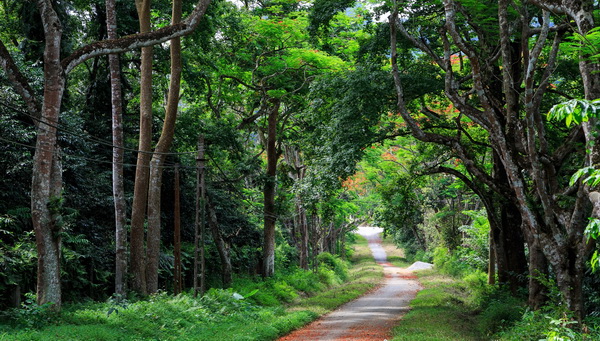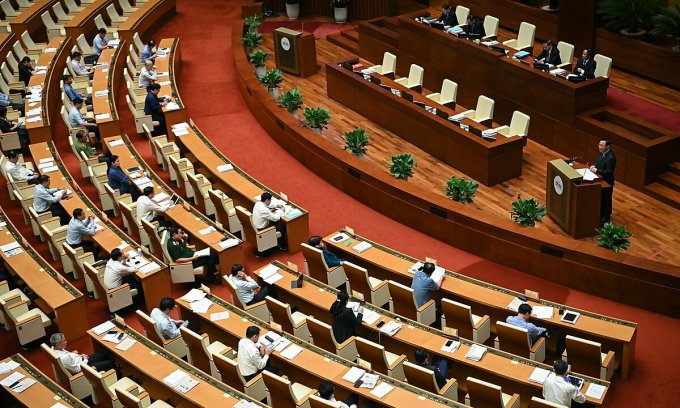Regulations on special-use forest land in Vietnam

Many people today still do not fully understand the role and meaning of forests in general and special-use forests in particular. Forests for use play a very important role for the country, for scientists. So about the matter “Regulations on special-use forest land in Vietnam” Let’s find out with LSX in the article below.
Legal grounds
- Land Law 2013
What is special-use forest land?
According to APPENDIX NO. 01- Explaining how to determine the type of land, types of land users, types of land management objects- promulgated together with Circular No. 27/2018/TT-BTNMT dated December 14, 2018 of the Ministry The Minister of Natural Resources and Environment stipulates on statistics, land inventory and mapping of the current status of land use:
Land that is statisticed and inventoryed for the purpose of special-construction forest is the land currently under forest and the land being used for forest development for the main purpose of preserving natural forest ecosystems, forest biological genetic resources, and research. scientific research, conservation of historical-cultural relics, beliefs, scenic spots in combination with eco-tourism; convalescence and entertainment except for strictly protected subdivisions of special-use forests; provision of forest environmental services (such as national parks, nature reserves, species and habitat conservation areas, landscape protection zones including forests with historical-cultural relics, scenic spots); belief forest; urban environmental protection forest, industrial park, export processing zone, economic zone, high-tech park; scientific research and experimental forest; national botanical garden; national seed forest) .
Special-use forest land includes: land with special-use forests being natural forests, land with special-use forests being planted forests and land being used for protection and development of special-use forests.
Special-use forest land has the role of preserving the national wild nature, preserving precious species of animals. Not only animals, plants are also preserved, avoiding the case of exploitation and extinction of species. Special-use forests must follow the standard model of the ecosystem, ensuring all mandatory elements. Special-use forest land also helps to protect the country’s historical relics and maintain famous landmarks. Not only that, this type of soil is also used for scientific research. Currently, most of the special-use forests are deployed into tourist areas for customers to visit, rest and relax.
Classification of special-use forests
- National Parks
This is a natural land formed to protect one or more ecosystems. It should meet the following requirements: It must be a natural land consisting of a standard sample of an intact primary ecosystem or with little or no human impact or forests of high cultural value and travel; Having an area large enough to accommodate one or more ecosystems, unaltered by adverse human impacts; Traffic must be relatively convenient; The percentage of ecosystem area that needs to be preserved is 70% or more.
- Nature reserve
Also known as habitat species conservation area and nature reserve. This is a natural land established for the purpose of protecting the natural succession. A nature reserve should meet the following requirements: Being a natural land with a huge reserve of natural resources, especially with high biodiversity value; There are rare wildlife species or endemic plant and animal species; A place of high value in education, science and tourism; Having an area large enough to accommodate one or more ecosystems and a conservation rate of >70%.
- Forest of culture – history – environment
This is an area with one or more landscapes of cultural and historical value. Created for the purpose of serving cultural, tourist or research activities, including: Areas with cultural and historical relics that have been ranked in the country and the world; An area with scenic spots on the coast, islands or mainland.
Principles of protection and maintenance of special-use forest land development
Special-use forests are set with certain principles to ensure good ecosystem maintenance. The first rule is to ensure that natural forests grow, not allowed to be exploited. Conserve the natural landscape, store the biodiversity of special-use forests. On the other hand, special-use forests are often divided into 3 areas: administrative services, ecological restoration, and protection. These 3 zones are linked together, the common purpose is nature conservation
Regulations on special-use forest land in Vietnam
According to state regulations, neither households nor individuals have the right to receive special-use forest land. You cannot grant the right to use agricultural or non-agricultural land within the special-use forest. The only condition is that you must have a household registration certificate and live in a special-use forest area. If you still have questions about buying and selling land in special-use forests, you should use real estate legal advice.
On the other hand, when you are living within a strictly protected subdivision, it is necessary to comply with the law. During your life, you are not allowed to transfer, donate or sell special-use forest land. The time you are there, apart from farming, forestry and fishing, do not do any other work. Fully comply with regulations on exploitation of forest resources, including within residential land. Thus, you will not violate the law on destruction and exploitation of special-use forests.
Characteristics of special-use forests
Special-use forests are divided into the following categories:
1) Nature Reserve: A protected area with scientific value, keeping the genetic resources of animals and plants. The nature reserve may be open to serve scientific research but not open to restoration. tourism services and other cultural needs;
2) National Park: The protected area has comprehensive use value in terms of nature protection, scientific research, preservation of cultural relics, sightseeing and tourism services;
3) Socio-cultural, research-experiment forest: The area has historical and cultural relics and landscapes with aesthetic value or environmental protection value, which have the effect of serving sightseeing and tourism. leisure, leisure, or scientific research.
Based on ecological characteristics and operational functions of specific areas in the forest, special-use forests are divided into several areas, including: Strictly protected areas (also called core zones); ecological restoration area; and administrative and service areas.
In addition, mentioning the special-use forest cannot fail to mention the buffer zone, although the area of the buffer zone is not included in the area of special-use forest.
Buffer zone is an area of forest, land or land with water surface close to the border with National Parks and Nature Reserves, which has the effect of preventing or mitigating the encroachment of special-use forests.
All activities in the buffer zone are aimed at supporting the conservation, management and protection of special-use forests. Limiting migration from outside into the buffer zone, banning hunting, trapping and trapping animals and cutting down wild plant species are objects of protection.
The buffer zone benefits the people living around the NR. This can be done by applying specific development activities, especially contributing to improving the socio-economic life of residents living in the buffer zone.
The function of the buffer zone is: to contribute to the protection of the protected area it surrounds; improve the conservation values of the buffer zone itself; create conditions to bring the people living in the buffer zone benefits from the buffer zone and the protected area.
Responsibilities of special-use forest management agencies
The Ministry of Agriculture and Rural Development is responsible to the Government for performing the state management of the special-use forest system nationwide; directly organize the management of special-use forests located in the area of 02 provinces or centrally-run cities or more.
Provincial-level People’s Committees perform the state management over the local special-use forest system.
Services of LSX
Prestigious professional services: Firstly, the team of consultants and consultants for many years in the field of civil status, and customer support.
On-time: Certainly, with the motto “Get your lawyer right at your fingertips”, we ensure the service always performs on time. The rights and interests of customers always come first.
Cost: Besides, LSX’s service costs are highly competitive; depending on the nature of the particular case. So, we want our guests to have the best possible service experience. Therefore, costs which guaranteed to be the most suitable and economical for customers.
Confidentiality of client information: Finally, all brand information of client LSX will be 100% confidential.
Please contact us immediately if you have any questions about “Regulations on special-use forest land in Vietnam”
Contact LSX
Finally, hope this article is useful for you to answer the question about “Regulations on special-use forest land in Vietnam” If you need any further information, please contact LSX Law firm: at +84846175333 or Email: [email protected]
Please see more
- Regulations on public land planning in Vietnam
- Sequence of recovering encroached land in Vietnam
- Leasing production forest land according to Vietnam law
Frequently asked questions
A national park meets the following criteria:
a) Having at least 01 typical natural ecosystem of a region or of the country, internationally or at least 01 species of organisms endemic to Vietnam or more than 5 species on the list of forest plants, animals and animals. endangered, precious and rare forest animals;
b) Having special scientific and educational value; has environmental landscape, unique beauty of nature, has value for eco-tourism, convalescence and entertainment;
c) Having a contiguous area of at least 7,000 ha, of which at least 70% of the area is forest ecosystems.
a) Having a project to establish a special-use forest in accordance with the national forestry master plan, not falling into the subjects specified at Point c, Clause 1, Article 8 of Decree No. 65/2010/ND-CP dated June 11, 2010 of the Government detailing and guiding the implementation of a number of articles of the Law on Biodiversity 2008;
b) Meeting the criteria for each type of special-use forest as prescribed in Article 6 of this Decree.
Contents of the project to establish a special-use forest
a) Assessment of natural conditions, current status of forests and natural ecosystems; biodiversity values, biological genetic resources; historical, cultural, landscape, eco-tourism, convalescence and entertainment values; science, experimentation, environmental education and provision of forest environmental services;
b) Assessment of the current status of management and use of forest, land and water surface in the project area;
c) Assessment of the current situation of people’s livelihood, economy – society;
d) Determining the objectives of establishing a special-use forest meeting the criteria of a special-use forest;
) Determine the boundary range, area of the special-use forest, subdivisions and buffer zones on the map;
e) Operational programs and plans for stabilizing people’s life in the buffer zone, solutions for implementation, organization and management;
g) Determination of investment capital estimates, investment phases for construction of special-use forests; regular funding for activities of forest protection, conservation and improvement of people’s lives; invest effects;
h) Organizing the implementation of the project.
Conclusion: So the above is Regulations on special-use forest land in Vietnam. Hopefully with this article can help you in life, please always follow and read our good articles on the website: lsxlawfirm.com




